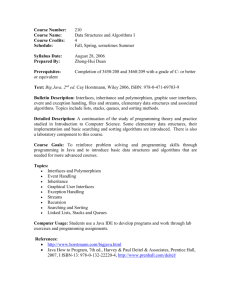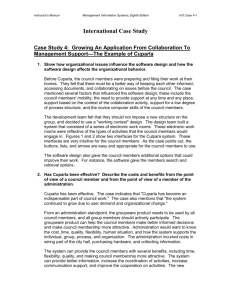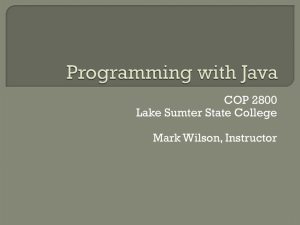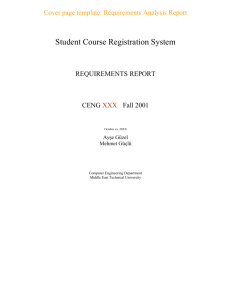Abstract Classes
advertisement
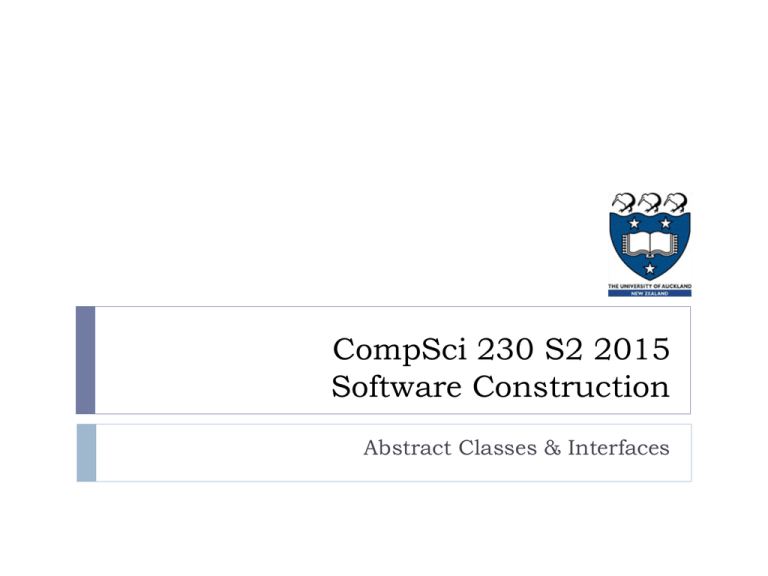
CompSci 230 S2 2015
Software Construction
Abstract Classes & Interfaces
Agenda & Reading
Topics:
Abstract Classes
Interfaces
Abstract Classes VS Interfaces
Interfaces, revisited
Extending Interfaces
The Final keyword
Reading
The Java Tutorial:
Abstract Methods and Classes
Writing Final Classes and Methods
Interfaces
Java 2 – The Complete Reference
2
Abstract Classes: Chapter 8, page 216-221
Interfaces: Chapter 9, page 235-247
07
Example: ShapesDemo.java
Rectangle, Circle and Triangle
repeating
General methods:
Bad design!
Specific methods: (need to know the type)
3
get(), getY(), setX(…), setY(…), translate(…)
draw(…), area()
07
Point
Shape
Common
Instance variables: Point p (top left corner)
Methods: set, get and translate (common to all shapes)
Specific methods : draw, area
Need to draw/calculate an area for all shapes
But this is done differently for different shapes
Use an array of Shape
Create an array to store different shapes
Shape.Area()/Shape.Draw()?
Create an array
Shape[] s = new Shape[3];
S[0] = new Rectangle(…);
…
for (int i =0; i< s.length; i++) {
s[i].draw(g);
Invoke the draw
}
method
It might not be appropriate to have any code for the area() method in the Shape class at all
(you don’t know how to calculate the area of an object if you don’t know the type of the
shape).
public class Shape {
...
public void draw(Graphics g){??????
public abstract int area(){???????
...
4
public class Shape {
protected Point p; //top-left corner
public int getX() { return p.x; }
...
Code Reuse
Circle
Add a new class : Shape
Square
Use of Inheritance :
Triangle
Need to Change
07
Abstract classes
public abstract class Shape {
…
public abstract void draw(Graphics g);
public abstract int area();
}
Remove the code inside the area()
method and make the method abstract
Example: abstract/ShapesDemo.java
Abstract methods
Provide implementation
in subclasses
public class Rectangle extends Shape {
private int width, height;
public int area() {
return (width * height);
}
...
public class Circle extends Shape {
private int radius;
public int area() {
return (int) (Math.PI * radius * radius);
}
...
public class Triangle extends Shape {
private int width, height;
public int area() {
return (width * height) / 2;
}
5
...
07
Abstract Classes
Aim:
What goes in an abstract class?
Implementation of common state and behaviour that will be inherited by subclasses
Declaration of generic behaviours that subclasses must implement
How?
Abstract classes permit declaration of classes that define only part of an
implementation, leaving the subclasses to provide the details
By using the abstract keyword in the class header and in any generic (abstract)
methods
Rules
An abstract class is not required to have an abstract method in it.
But any class that has an abstract method in it or that does not provide an implementation
for any abstract methods declared in its superclasses must be declared as an abstract class.
An abstract method has no implementation
When a class inherits from an abstract class, it must implement every abstract
member defined by the abstract class
An abstract class cannot be instantiated, however references to an abstract class can
be declared.
Shape s = new Rectangle(10, 20, 30, 40);
Shape s = new Shape(); <- wrong
6
07
Java Interfaces
If an abstract class contains only abstract method declarations, it should be
implemented as an interface instead.
Java Interface
Defines a protocol of behaviour that can be implemented
Defines a set of methods but does not implement them (no actual implementation)
Contains:
Method headers (signatures)
Field definitions (Must be class constants: public, static, final only)
is never directly instantiated
Example:
Interface in everyday life: VCR
Methods are implicitly abstract,
so the abstract keyword is not
required in a method declaration
public interface VCR {
public boolean loadTape(String tapeName);
public boolean eject();
public boolean play();
public boolean pause();
public boolean stop();
...
public static final int PLAYING=0, PAUSED=1, STOPPED=2,
FORWARD=3, BACKWARD=4, NOTAPE=5;
}
7
07
Example: Basketball.java
Example 1
Bounceable Interface
Hitwall(String wallname)
public class Basketball implements Bounceable {
public void hitWall(String wallName) {
System.out.println("I hit " + wallName);
System.out.println("G is " + GRAVITY);
}
public static void main(String[] args) {
Basketball b = new Basketball();
b.hitWall("Wall A");
}
}
Data fields are implicitly
public, static and final
public interface Bounceable {
double GRAVITY = 9.8;
void hitWall(String wallName);
}
Methods are implicitly abstract
8
07
Example 2 - MouseListener
MouseListener Interface
The listener interface for receiving "interesting" mouse events (press,
release, click, enter, and exit) on a component
public interface MouseMotionListener ... {
mouseDragged(MouseEvent e)
mouseMoved(MouseEvent e)
}
MouseMotionListener Interface
9
public interface MouseListener ... {
mouseClicked(MouseEvent e)
mouseEntered(MouseEvent e)
mouseExited(MouseEvent e)
mousePressed(MouseEvent e)
mouseReleased(MouseEvent e)
}
The listener interface for receiving mouse motion events on a
component
07
Abstract classes Vs Interfaces
Abstract classes Vs Interfaces
An interface cannot implement any methods, whereas an abstract class can.
(i.e. An interface is where all the methods are abstract)
A class that implements an interface must either provide definitions for all
methods or declare itself abstract
Classes can extend only one class, but can implement one or more
interfaces
Unrelated classes can implement the same interface
Interface Continuum
Concrete
super class
Abstract class
Use extends
to make subclass
(At least one method is abstract)
Use extends to make subclass
10
Completely
abstract class
or interface
A subclass
implements
the interface
07
Interfaces, revisited
An Interface is like a Class, with no bodies in the
methods. It may define constants (public static
final) but no runtime variables.
Usually, an Interface is public.
The Java Tutorials:
11
An interface provides a standard way to access a class which could
be implemented in many different ways.
“There are a number of situations in software engineering when it
is important for disparate groups of programmers to agree to a
‘contract’ that spells out how their software interacts.”
“Each group should be able to write their code without any
knowledge of how the other group's code is written.”
“Generally speaking, interfaces are such contracts.”
07
Implementations, in Java
In Java, a class which implements an interface must provide an
implementation of every method defined within the
interface
A class may implement some additional methods (but these extra
methods aren’t accessible through this interface)
Beware: adding another method to an existing Interface will “break”
every current implementation of this Interface!
A class can implement many interfaces.
An Interface can extend other Interfaces.
Extension is the preferred way to add new methods to an Interface.
12
(Do you understand why?)
In Java, classes are less extendible than interfaces, because a Class
can extend at most one other Class (“single inheritance”).
07
Example 3: Cups
Given a family of classes, polymorphism allows you to treat a
subclass object as if it were a superclass object
create a single method that could wash any kind of cup in your
virtual café.
public static void prepareACup(Cup cup) {
...
cup.wash();
...
The prepareACup() method can invoke wash() on many different
objects
class Cup {
public void wash() {
...
class CoffeeCup extends Cup {
public void wash() {
...
13
class EspressoCup extends CoffeeCup {
public void wash() {
...
class CoffeeMug extends CoffeeCup {
public void wash() {
...
07
Washable?
What if you wanted to have a method that can wash any kind
of object ("washable" object)?
For example: wash a window, wash your car, or wash a dog
Objects don't seem to fit into the same family
Dog{
You may want to… classpublic
void wash() {
class Window {
public void wash() {
...
...
class Cleaner {
public static void cleanAnObject(Object obj) {
if (obj instanceof Cup) {
((Cup) obj).wash();
} else if (obj instanceof Dog) {
((Dog) obj).wash();
class Car {
public void wash() {
...
doesn't use
polymorphism
} else if ...
14
07
WashableObject family
Four families--cups, cars, windows, and dogs--are combined into
the WashableObject family
Full benefit of polymorphism in the cleanAnObject() method
abstract class WashableObject {
public abstract void wash();
}
class Window extends WashableObject {
public void wash() {
...
class
Dog extends WashableObject {
public void wash() {
...
class Cleaner {
public static void cleanAnObject(WashableObject wo) {
//...
wo.wash();
However ..
15
What exactly is a washable object? What does one look like? Washable is an
adjective, not a noun. It describes a behaviour exhibited by objects, not an
object itself
07
Washable Interface
Interfaces in Java allow you to get the benefits of polymorphism
without requiring you to build a singly-inherited family of classes.
Although a class can extend only one other class, it can
"implement" multiple interfaces.
Solution
16
Family of classes for cups, another for animals, one for vehicles (including
cars), one for parts of a building etc
Then each washable class can implement the Washable interface.
07
Extending Interfaces
Interfaces can extend other interfaces, which brings rise to sub-interfaces
and super-interfaces
Interface extends interface, but a class cannot extends an interface.
Unlike classes, however, an interface can extend more than one class at a
time
public interface Displayable extends Drawable, Printable {
//additional constants and abstract methods
...
}
Another good reason to extend interfaces is that INTERFACES
CANNOT GROW.
17
Think about when you add methods to a class that’s already being used by
other classes. It doesn’t effect them really, they can still use your class just as
before.
But, if you add methods to an interface, you break the classes that use this
interface, since they now must implement another method.
So, when something else is required in an interface, it is best to extend that
interface, add the new method and then use the new sub-interface.
07
Example 4
The new method
public interface Bounceable {
double GRAVITY = 9.8;
void hitWall(String wallName);
void AddMethod();
}
All classes that implement the old Bounceable interface
will break because they don't implement all methods of
the interface anymore.
Solution: write a new sub-Interface
Now users of your code can choose to continue to use the old
interface or to upgrade to the new interface
public interface Bounceable {
double GRAVITY = 9.8;
void hitWall(String wallName);
}
public interface BounceablePlus extends Bounceable {
void AddMethod();
}
18
07
Typing Rules
The typing rules for interfaces are similar to those for classes.
A reference variable of interface type T can refer to an instance of
any class that implements interface T or a sub-interface of T.
Through a reference variable of interface type T, methods defined
by T and its super interfaces can be called. interface I1 {
class c1 implements I1 {
public void m1() {}
public void m2() {}
}
C1 a = new C1();
C1 b = new C1();
I1 p = a;
p.m1();
p.m2();
C2 c = new C2();
I2 q = c;
q.m1();
q.m2()
q.m3();
19
public void m1();
public void m2();
}
inteface I2 extends I1 {
public void m3();
}
a is a reference variable of type C1
p is a reference variable of type I1
q is a reference variable of type I2
class c2
public
public
public
}
implements I2 {
void m1() {}
void m2() {}
void m3() {}
07
instanceof
You can use the instanceof operator to test an object to see
if it implements an interface, before you invoke a method in
this interface.
This might improve readability and correctness.
This might be a hack.
Where possible, you should extend classes and interfaces to obtain
polymorphic behaviour, rather than making a runtime check.
if( b instanceof Bounceable ) {
b.hitWall( "Wall A" );
}
20
07
Interfaces, in UML
Interfaces specify behaviour (a
public contract), without data or
implementation.
Interfaces are drawn like classes,
but without attributes, and with
the keyword <<Interface>>
A dotted open-triangle arrow,
from a class to an interface, means
that “the class implements this
interface”.
We also say that “the class fulfils the
contract specified by this interface”,
or that it “realizes the interface.”
21
Note that
interfaces define
methods but not
attributes.
A password allows
a secureLogin().
07
Final
The final keyword can be applied to prevent some of the
inheritance effects
Final field: constant
Final argument: cannot change the data within the called
method
Final method: cannot override method in subclasses
Final class: cannot be subclassed (all of its methods are implicitly
final as well)
class ChessAlgorithm {
. . .
final void nextMove(ChessPiece pieceMoved, BoardLocation newLocation) {
...
}
}
22
07
Interfaces in Java 8
In Java 8, an interface may contain
23
implementations of static methods, and
default implementations of instance methods
07
Default methods
It allows developer to add new methods to the Interfaces
without breaking the existing implementation of these
Interface.
Java 8 allows default methods to be added to interfaces with their
full implementation
Classes which implement the interface don’t have to have
implementations of the default method
interface A {
public default void foo(){
System.out.println("Calling A.foo()");
}
}
AImpl obj = new AImpl();
obj.foo();
24
class AImpl implements A {
public void existingMethod() {
System.out.println("existing");
}
}
Output: Calling A.foo()
07
Static methods
A static method is associated with a class not with the object.
Static method works as helper method. So if we declare static methods in
interface, it is easy for us to organize our helper methods.
interface Village {
void setNumOfPeople(int num);
void setName(String name);
static int getVillageId(){
return 1;
}
default String getBusinessType(){
return "Business type is Farming
}
}
and village id:"+getVillageId();
Business type is Farming and village id:1
Village id:1
Location Id:1
class Location implements Village {
public int noOfPeople;
public String name;
...
public int getLocationId(){
return Village.getVillageId();
}
}
Location lo = new Location();
System.out.println(lo.getBusinessType());
System.out.println("Village id:"+Village.getVillageId());
System.out.println("Location Id:"+lo.getLocationId());
25
07




